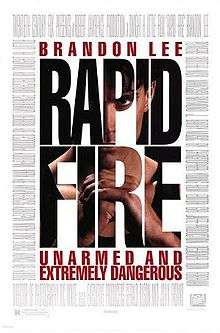Rapid Fire (1992 film)
| Rapid Fire | |
|---|---|
 Theatrical release poster | |
| Directed by | Dwight H. Little |
| Produced by | Robert Lawrence |
| Written by | Alan McElroy |
| Story by |
Cindy Cirile Alan McElroy |
| Starring | |
| Music by | Christopher Young |
| Cinematography | Ric Waite |
| Edited by | Gib Jaffe |
| Distributed by | 20th Century Fox |
Release dates |
|
Running time | 95 minutes |
| Country | United States |
| Language |
English Cantonese Italian |
| Budget | $10 million |
| Box office | $14,356,479 (US)[1] |
Rapid Fire is a 1992 American action film directed by Dwight H. Little, and starring Brandon Lee, Powers Boothe and Nick Mancuso. The film was released in the United States on August 21, 1992.
Lee was reportedly in talks with 20th Century Fox about making Rapid Fire 2, prior to his death. School scenes were filmed at Occidental College in Los Angeles. Many of the fight scenes were orchestrated by Lee, which contain elements of his father Bruce Lee's Jeet Kune Do fighting style.[2]
Plot
The film opens in Thailand, with Antonio Serrano (Nick Mancuso), a mafia drug distributor visiting long-time associate Kinman Tau (Tzi Ma), a drug kingpin. Serrano is having troubles and wants them to work together, but his request is not reciprocated.
Turned off from politics after witnessing the death of his father at Tiananmen Square in China, Los Angeles art student Jake Lo (Brandon Lee) is lured to a party of Chinese pro-democracy activists. While there, Jake witnesses Serrano killing party sponsor Carl Chang (Michael Paul Chan), who was an associate of Tau. A reluctant Jake is placed under protective custody by federal agents and brought to Chicago to testify against Serrano.
Some of the agents placed to protect him are corrupt and try to kill Jake, who manages to escape. Another attempt is thwarted by Lieutenant Mace Ryan (Powers Boothe), a Chicago cop who has been after Tau for 10 years. Jake is brought to his base, where he becomes acquainted with his team - Detective Karla Withers (Kate Hodge) among them, whom he begins to develop feelings for.
However, Jake remains reluctant, but is persuaded by Ryan to join in the efforts to arrest Serrano and obtain information about Tau's next shipment. After a barrage of violence, they are narrowly successful, but Jake assaults Ryan after realising his involvement wasn't necessary. Karla reveals to Jake that she has information about his father, and the two return to her apartment where a heated confrontation leads to the young ones making love.
While the couple romance each other, Ryan leads an unsuccessful raid at the revealed location of the next shipment: Tau's laundry factory, while Serrano is murdered by one of Tau's henchmen. Ryan is left bitterly disappointed, but is reunited with Jake, as they, and Withers attempt to bring down the operation once more.
Cast
- Brandon Lee as Jake Lo
- Powers Boothe as Lieutenant Mace Ryan
- Nick Mancuso as Antonio Serrano
- Raymond J. Barry as Agent Frank Stewart
- Kate Hodge as Detective Karla Withers
- Tzi Ma as Kinman Tau
- Tony Longo as Brunner
- Michael Paul Chan as Carl Chang
- Dustin Nguyen as Paul Yang
- Brigitta Stenberg as Rosalyn
- Basil Wallace as Agent Wesley
- Al Leong as Minh
- François Chau as Farris
- Quentin O'Brien as Agent Daniels
- Roy Abramsohn as Agent Klein
- C'Esca Lawrence as Lisa Stewart
- Michael Chong as John Lo
- Jeff McCarthy as Agent Anderson
Release
The film is debuted at No.3 at the box office.[3]
After Brandon Lee's death while filming The Crow, his films, such as Rapid Fire, saw a surge in video sales.[4] 20th Century Fox Home Entertainment released the DVD in Region 2 in the United Kingdom on 16 July 2001, and Region 1 in the United States on May 21, 2002.
Reception
Rapid Fire received mostly mixed reviews.[5][6][7][8]
References
- ↑ "Rapid Fire". Box Office Mojo. Retrieved 2014-09-27.
- ↑ "Brandon Lee follows father's footsteps". Baltimore Sun. Retrieved 2010-09-20.
- ↑ Fox, David J. (1992-08-25). "Weekend Box Office `Unforgiven' at Top for Third Week". The Los Angeles Times. Retrieved 2010-12-01.
- ↑ Hunt, Dennis (1993-04-09). "A Resurgence of Interest in Films of Brandon Lee". The Los Angeles Times. Retrieved 2010-12-03.
- ↑ "Lee's charm is raked by 'Rapid Fire'". Baltimore Sun. Retrieved 2010-09-20.
- ↑ Siskel, Gene (1992-08-21). "Dump `Rapid Fire,` But Keep Brandon Lee". Chicago Tribune. Retrieved 2010-09-20.
- ↑ Thomas, Kevin (1992-08-21). "'Rapid Fire' Launches Heir to Lee's Kung Fu Legacy". The Los Angeles Times. Retrieved 2010-09-20.
- ↑ Holden, Stephen (1992-08-21). "Review/Film; Violence Compounded by More Violence". The New York Times. Retrieved 2010-12-14.